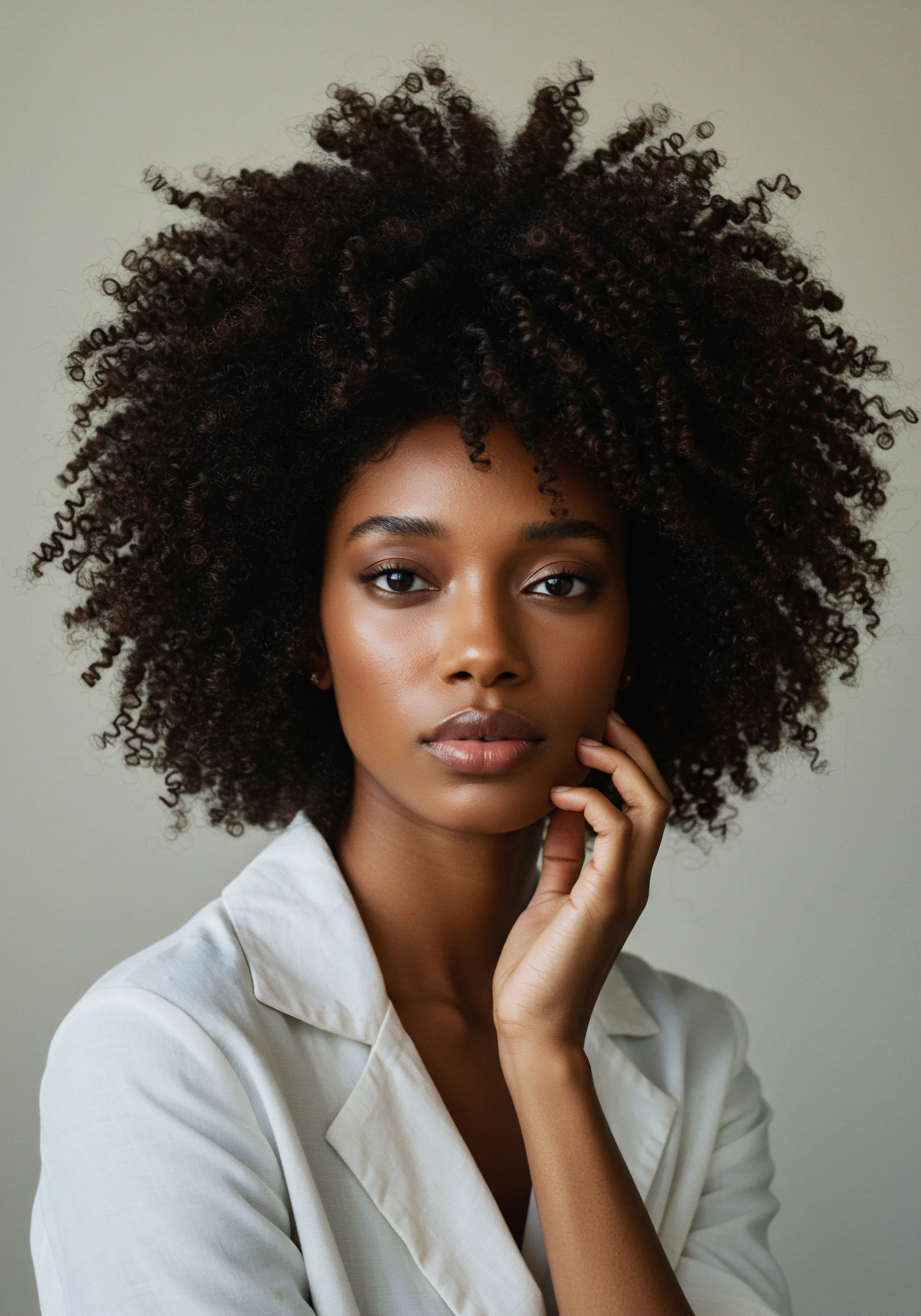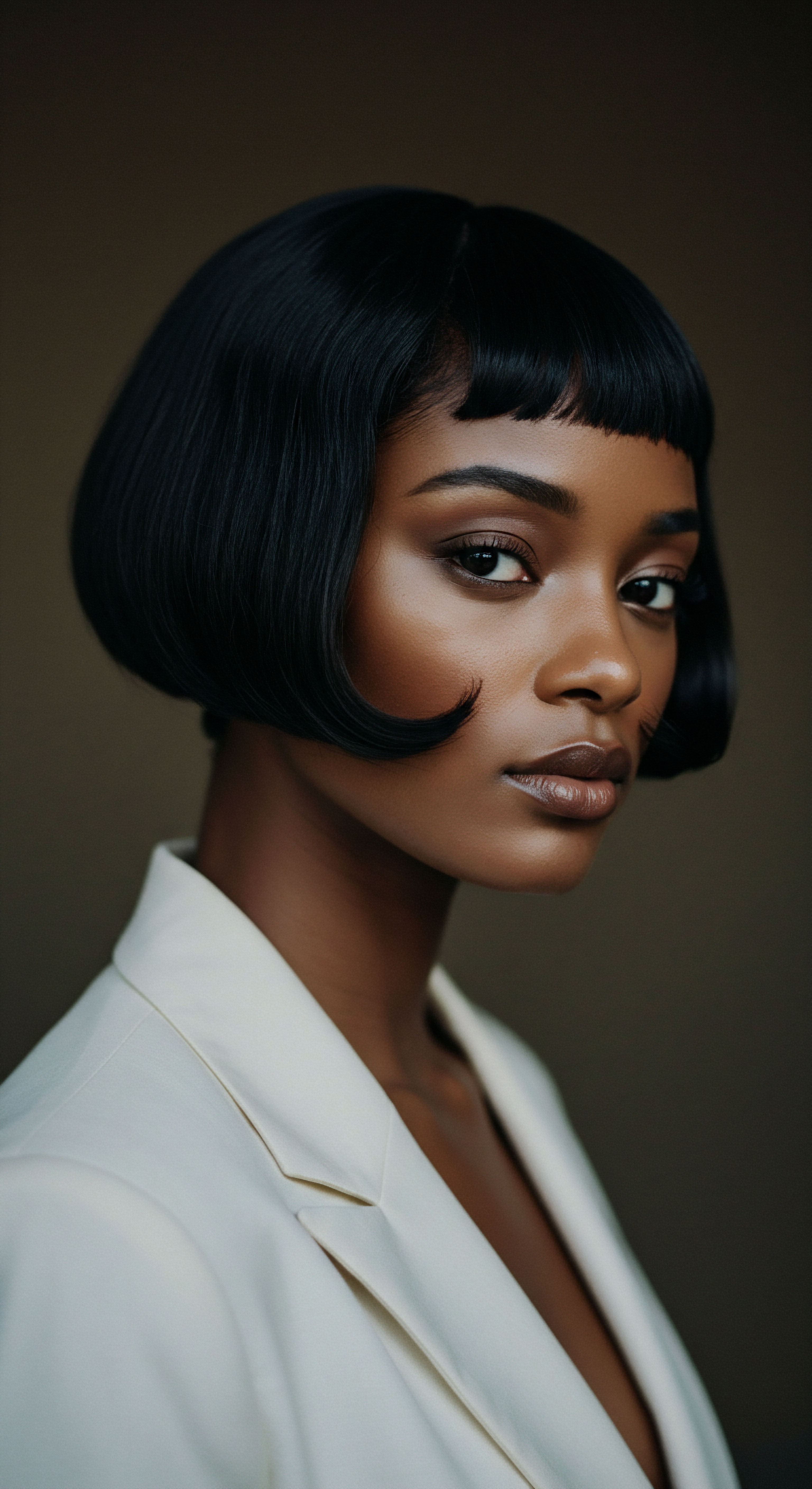
Roots
The quiet observation of a single strand, perhaps caught on a brush or illuminated by sunlight, can stir a profound curiosity about its hidden resilience. We hold our hair as a part of ourselves, yet its true workings, its intricate design, often remain veiled. To truly comprehend how ancient practices might speak to hair’s ability to hold water, we must first descend into its very core, understanding the architecture that grants it life and strength. This initial exploration lays the groundwork, revealing the elemental truths of hair’s structure and its intrinsic connection to moisture.

The Hair’s Inner World
Each hair strand, far from a simple filament, is a complex, layered creation. At its heart lies the Medulla, a soft, sometimes absent, central core. Surrounding this is the Cortex, the thickest layer, composed primarily of keratin proteins. These proteins, arranged in fibrous bundles, grant hair its remarkable strength, elasticity, and hold its natural pigment.
The cortex acts as a sponge, capable of absorbing significant amounts of water, influencing hair’s diameter and overall pliability. Over-absorption, however, can lead to swelling and, in time, damage.
Encasing the cortex is the Cuticle, the outermost protective shield. Imagine it as a series of overlapping scales, much like shingles on a roof. When healthy, these scales lie flat, smooth, and tightly bound, creating a formidable barrier. This alignment is not merely for aesthetics; it plays a decisive role in regulating what enters and exits the hair shaft.
A well-sealed cuticle minimizes moisture loss from the cortex, preserving hydration and imparting a natural sheen. Conversely, a raised or compromised cuticle allows water to escape too readily, leading to dryness and frizz.
The hair’s inner architecture, particularly the cortex and its protective cuticle, dictates its fundamental interaction with water.

The Cuticle’s Guarding Role
The cuticle’s condition directly impacts hair porosity, which describes the hair’s ability to absorb and retain moisture.
- Low Porosity Hair ❉ Exhibits tightly packed cuticle scales, making it resistant to moisture absorption but excellent at retention once hydration is achieved. Products may sit on the surface rather than penetrating.
- Medium Porosity Hair ❉ Possesses a slightly looser cuticle layer, allowing for balanced absorption and retention, often considered the most manageable hair type.
- High Porosity Hair ❉ Characterized by gaps or lifted scales in the cuticle, absorbing water quickly but losing it just as rapidly, leading to dryness and breakage. This can be due to genetics or damage from chemical treatments, heat, or environmental factors.
Beyond the physical scales, a delicate Lipid Layer coats the hair’s surface, acting as a natural water-repellent barrier. This hydrolipidic film, composed of fatty acids, ceramides, and cholesterol, helps seal the cuticle, preventing moisture loss and providing protection against environmental aggressors. Its integrity is paramount for maintaining balanced hydration and hair health.
| Hair Layer Medulla |
| Composition Soft, central core (not always present) |
| Role in Water Retention Limited direct role in hydration |
| Hair Layer Cortex |
| Composition Keratin proteins, pigment |
| Role in Water Retention Primary site of water absorption, provides elasticity |
| Hair Layer Cuticle |
| Composition Overlapping scales (dead cells) |
| Role in Water Retention Regulates water entry and exit, protects inner layers |
| Hair Layer Lipid Layer |
| Composition Fatty acids, ceramides, cholesterol |
| Role in Water Retention Forms a protective barrier, seals cuticle, prevents moisture loss |
| Hair Layer Each component works in concert to determine hair's ability to hold moisture. |

Ritual
As we turn our attention from the hidden architecture of hair to the deliberate actions we take to care for it, a sense of practical wisdom begins to surface. For generations, individuals have engaged in practices, passed down through families and communities, that speak to an intuitive understanding of hair’s needs. These traditions, often steeped in natural elements, aimed not just for aesthetic appeal, but for sustained vitality. Let us consider how these time-honored customs, the very rituals of hair care, laid foundations for lasting water retention.

The Wisdom of Oils
Across various ancient cultures, the application of natural oils stood as a fundamental practice for hair care. From the Mediterranean’s use of olive oil to the deep traditions of Ayurvedic and African communities with coconut, almond, and shea butter, these oils were not simply conditioners but integral components of hair wellness. Their efficacy in promoting water retention stems from their ability to coat the hair shaft, forming a protective film that helps seal the cuticle. This external barrier reduces the rate at which water evaporates from the hair’s internal structure, thereby preserving the moisture already present within the cortex.
Certain oils, particularly those rich in specific fatty acids, exhibit a unique ability to penetrate the hair shaft. Coconut Oil, for example, with its high concentration of lauric acid, a medium-chain fatty acid, possesses a molecular structure small enough to pass through the cuticle and reach the cortex. This penetration can help reduce protein loss during washing, indirectly contributing to the structural integrity that supports better water retention over time. While direct internal structural change is complex, the consistent use of such oils can bolster the hair’s external defenses, creating an environment conducive to maintaining hydration within.

Herbal Infusions and Hair’s Thirst
Beyond oils, ancient societies turned to the bounty of the earth for hair rinses and treatments. Herbal infusions, often prepared from plants like Rice Water, aloe vera, or various Ayurvedic herbs such as amla and bhringraj, were common. These botanical concoctions offered a spectrum of benefits. Rice water, for instance, has been historically used in East Asian cultures, notably by the Yao women, for its purported ability to strengthen hair and enhance elasticity.
Scientific examination suggests that components within rice water, like inositol, can reduce surface friction and potentially repair damaged hair from the inside out, though direct effects on growth are less clear. A smoother, less frictional surface implies a more aligned cuticle, which in turn aids in sealing moisture within.
Ancient hair care rituals, particularly the application of natural oils and herbal rinses, created protective external barriers that significantly aided in water retention by sealing the hair’s cuticle.
The pH of these rinses also played a subtle yet important role. Hair’s natural pH is slightly acidic, typically between 4.5 and 5.5. Many traditional herbal rinses, or even fermented rice water, tend to fall within this slightly acidic range, which helps to flatten and close the cuticle scales.
A closed cuticle is less prone to moisture loss and external damage, thereby contributing to sustained hydration. This chemical interaction, though perhaps not explicitly understood in ancient times, was intuitively applied through observation and generations of practice.

Protective Traditions and Their Impact
The history of hair care is also a story of protection. Many ancient and traditional practices, particularly within textured hair communities, centered on safeguarding the hair from environmental stressors and mechanical damage. Styles like braids, twists, and various forms of updos were not merely aesthetic choices but practical strategies to minimize manipulation, friction, and exposure. By keeping hair bundled and shielded, these styles reduced the opportunity for the cuticle to become raised or chipped, which directly impacts water retention.
Consider the impact of constant exposure to sun, wind, and dust. These elements can degrade the hair’s external lipid layer and lift cuticle scales, leading to increased porosity and moisture loss. Protective styles offered a physical shield against such daily assaults.
- Oiling and Sealing ❉ Regularly applying oils, especially those known to penetrate the hair shaft, forms a protective barrier that helps seal the cuticle and reduce protein loss.
- Herbal Rinses ❉ Using acidic or pH-balancing rinses can help flatten the cuticle, thereby improving its ability to hold moisture.
- Protective Styles ❉ Minimizing environmental exposure and mechanical manipulation through braiding or other styles reduces cuticle damage and preserves internal hydration.
These methods, often employed with a gentle touch and consistent application, contributed to maintaining the hair’s integrity over long periods. While they may not have fundamentally altered the chemical bonds within the cortex, they certainly optimized the cuticle’s function, which is the gateway to internal hydration.
| Practice Natural Oil Application |
| Primary Mechanism Forms external coating, penetrates cuticle (certain oils) |
| Impact on Water Retention Reduces moisture evaporation, minimizes protein loss |
| Practice Herbal Rinses (e.g. Rice Water) |
| Primary Mechanism pH balancing, surface smoothing |
| Impact on Water Retention Flattens cuticle, reduces friction, aids in moisture sealing |
| Practice Protective Hair Styles |
| Primary Mechanism Physical barrier against environmental/mechanical damage |
| Impact on Water Retention Minimizes cuticle damage, preserves external lipid layer |
| Practice These practices worked synergistically to maintain hair's hydration and overall health. |

Relay
To truly grasp the enduring influence of ancient hair care practices on hair’s internal structure and its water retention capabilities, we must venture beyond the immediate surface. This inquiry demands a multi-dimensional perspective, one that intertwines the wisdom of the past with the rigorous insights of contemporary science. How do consistent, gentle approaches, often dismissed as mere folk remedies, contribute to the very resilience of the hair fiber over a lifetime? The answer lies in a subtle, cumulative effect, where external care translates into internal stability, profoundly impacting the hair’s ability to hold life-giving water.

The Long Whisper of Consistency
Hair, despite its appearance, is a dynamic structure, constantly interacting with its environment. Modern understanding reveals that repeated cycles of swelling and drying, often caused by harsh products or excessive manipulation, can lead to a phenomenon known as Hygral Fatigue. This condition arises when excessive moisture repeatedly penetrates the outer cuticle and reaches the inner cortex, causing the keratin proteins to stretch and contract.
Over time, this repetitive stress weakens the internal bonds that hold the hair’s proteins together, leading to a breakdown in the hair’s structural integrity. Symptoms include frizz, brittleness, and a general lack of vibrancy.
Ancient practices, characterized by their gentleness and consistency, often worked to mitigate this very issue. Consider the traditional emphasis on infrequent, mild cleansing and the regular application of natural emollients. These approaches minimize the extreme fluctuations in hydration that contribute to hygral fatigue.
By creating a stable external environment and supporting a healthy cuticle, these practices indirectly protected the internal keratin network from the constant stress of water absorption and desorption. This isn’t about changing the fundamental protein structure, but rather about preserving its inherent strength and flexibility.

Microscopic Views of Ancient Wisdom
The true impact of ancient practices on the internal structure, while not a direct chemical alteration of keratin bonds, lies in their ability to maintain the cuticle’s health, which is the gatekeeper of internal hydration. A compromised cuticle, with its lifted scales, not only allows water to escape but also makes the hair more susceptible to external damage that can degrade the cortex over time.
Research on the effects of certain traditional ingredients provides compelling data. For instance, a study on Coconut Oil revealed its capacity to reduce protein loss in both damaged and undamaged hair when used as a pre-wash or post-wash treatment. The small molecular weight of lauric acid in coconut oil allows it to penetrate the hair shaft, reaching the cortex and binding to hair proteins, thus preventing excessive swelling and subsequent protein degradation during washing. This preventative action, sustained over years of consistent application, contributes to a more resilient internal structure, one better equipped to retain water without succumbing to the weakening effects of hygral fatigue.
The enduring gentleness and consistency of ancient hair care practices indirectly fortify hair’s internal structure by preserving cuticle integrity and mitigating hygral fatigue.
Furthermore, the use of pH-balancing rinses, like those derived from fermented rice water or acidic fruit extracts, contributes to the closure and flattening of the cuticle. A closed cuticle reflects light better, contributing to shine, but more significantly, it acts as a more effective barrier against rapid water ingress and egress. This stability reduces the mechanical stress on the internal keratin fibers, allowing them to maintain their structural integrity and, consequently, their natural capacity for water binding.

The Biomechanical Dance of Water
Hair is hygroscopic, meaning it readily absorbs moisture from the air. The water molecules interact with the hydrophilic groups within the keratin proteins of the cortex. While some water absorption is natural and healthy, excessive or rapid swelling can lead to structural compromise.
Consider a specific case study ❉ The impact of traditional hair oiling on hair’s resistance to mechanical stress. A 2003 study published in the Journal of Cosmetic Science by Rele and Mohile, which examined the effect of mineral oil, sunflower oil, and coconut oil on hair, demonstrated that coconut oil was the only oil capable of reducing protein loss for both undamaged and damaged hair when applied before washing. This was attributed to its ability to penetrate the hair shaft. While the study primarily focused on protein loss, the preservation of protein directly relates to the cortex’s structural integrity and its capacity to manage water content effectively.
When the cortex’s protein network is preserved, it can better regulate the water it holds, preventing both excessive saturation and extreme dehydration. This subtle yet powerful effect, cultivated through centuries of practice, speaks to a deep, empirical understanding of hair’s needs.
The lipid layer, often replenished through ancient oiling rituals, plays a decisive role in this biomechanical dance. This layer, particularly the 18-methyl eicosanoic acid (18-MEA) component, is a key hydrophobic barrier on the hair’s surface. Damage to this layer, through chemical treatments or harsh environmental exposure, increases hair porosity and allows more water to enter the fiber, making it prone to damage. By consistently applying lipid-rich natural oils, ancient practices effectively maintained or restored this protective layer, thereby influencing how much water the hair absorbs and, critically, how well it retains it without suffering internal stress.
- Minimizing Hygral Fatigue ❉ Consistent, gentle practices reduce the damaging cycles of extreme swelling and contraction of keratin proteins.
- Cuticle Integrity ❉ Maintaining a smooth, closed cuticle via pH-balanced rinses and protective styles acts as a barrier against rapid moisture fluctuations and external damage.
- Lipid Layer Restoration ❉ Regular oiling replenishes the hair’s natural hydrophobic surface, controlling water absorption and reducing protein loss.
| Ancient Practice Consistent Oiling |
| Scientific Principle Supported Lipid layer preservation, protein loss reduction |
| Effect on Internal Structure/Water Retention Protects cortex from excessive swelling, improves moisture management |
| Ancient Practice pH-Balanced Rinses |
| Scientific Principle Supported Cuticle flattening and closure |
| Effect on Internal Structure/Water Retention Reduces porosity, limits rapid water exchange, maintains hydration |
| Ancient Practice Protective Styling |
| Scientific Principle Supported Minimizing mechanical and environmental stress |
| Effect on Internal Structure/Water Retention Preserves cuticle and cortex integrity, reduces damage that leads to moisture loss |
| Ancient Practice Ancient wisdom aligns with modern understanding of hair's biomechanical and chemical responses to care. |

Can Hair’s Core Be Remade by Old Ways?
The question of whether ancient practices can fundamentally change the internal structure of hair, rather than simply influencing its external state, leads us to a more nuanced consideration. While the core keratin structure of a mature hair fiber is largely fixed, the long-term, consistent application of practices that maintain its health can indeed influence its overall resilience and ability to retain water. This is not about rewriting the genetic code of a hair strand, but about optimizing its performance throughout its life cycle.
For instance, chronic cuticle damage, often from harsh chemical treatments or excessive heat, exposes the cortex to environmental insults, leading to degradation of its protein components. Ancient practices, by emphasizing gentle handling, natural ingredients, and protective measures, minimize this damage. By preventing the breakdown of existing internal structures, they allow the hair to function at its optimal capacity for water binding. This preventative care, over decades, results in hair that is inherently stronger and more resistant to the environmental factors that typically lead to moisture loss.
Ancient hair care practices, through their long-term, consistent application, do not rewrite hair’s core structure but rather optimize its inherent ability to retain water by safeguarding its integrity.
The influence extends to the hair’s response to swelling. Hair naturally swells when wet, and while this is a normal process, excessive swelling can be detrimental. Traditional oils, by forming a barrier, can moderate the rate of water absorption, preventing the rapid, damaging swelling that contributes to hygral fatigue.
This moderation allows the hair’s internal keratin network to remain more stable, preserving its elastic properties and its capacity to hold water without becoming overly porous or weakened. The interplay between external application and internal preservation is a testament to the sophisticated understanding embedded within these historical traditions.

Reflection
As the light fades on our exploration, a profound appreciation for the enduring wisdom of ancient hair care practices remains. We have traversed the microscopic landscape of the hair strand and observed the deliberate, often intuitive, rituals that once guided its care. The echoes of these traditions, spanning continents and generations, remind us that the quest for hair vitality is not a modern invention but a timeless pursuit.
The ability of hair to hold water, a simple yet vital function, is not merely a matter of product application but a delicate dance with its very structure, a dance that our ancestors understood with remarkable clarity. Their methods, steeped in observation and natural elements, laid the groundwork for hair that did not just survive, but truly thrived, carrying within its coils and strands the memory of practices that nurtured its deepest needs.

References
- RELE, A. S. & MOHILE, R. B. (2003). Effect of mineral oil, sunflower oil, and coconut oil on prevention of hair damage. Journal of Cosmetic Science, 54(2), 175-192.
- Robbins, C. R. (2012). Chemical and Physical Behavior of Human Hair (5th ed.). Springer.
- Bouillon, C. & Wilkinson, J. B. (2005). The Science of Hair Care. CRC Press.
- Gupta, A. K. (2008). Hair ❉ Physical and Chemical Properties. Allured Publishing Corporation.
- Choe, S. J. et al. (2017). Hair and Scalp Diseases ❉ A Comprehensive Guide. Springer.
- Singh, R. Wang, Y. & Ng, K. (2017). Human Hair ❉ From the Follicle to the Fiber. Royal Society of Chemistry.
- Velasco, M. V. R. et al. (2009). Hair cosmetics ❉ an overview. Brazilian Journal of Pharmaceutical Sciences, 45(3), 475-484.
- Shavandi, A. et al. (2017). Keratin as a Biopolymer. Springer.
- Cruz, C. et al. (2016). Hair Science ❉ The Art and Science of Hair Care. Elsevier.
- Herrmann, H. & Aebi, U. (2016). Intermediate filaments ❉ structure and assembly. Cold Spring Harbor Perspectives in Biology, 8(2), a018242.
- Lima, L. R. et al. (2019). Hair Growth ❉ A Comprehensive Review. Journal of Cosmetic Dermatology, 18(2), 341-352.
- Barba, C. (2007). Water absorption/desorption of human hair and nails. Journal of Cosmetic Science, 58(2), 163-176.
- Gavazzoni Dias, M. F. R. (2015). Hair cosmetics ❉ an overview. International Journal of Trichology, 7(1), 2-15.
- Draelos, Z. D. (2010). Hair Cosmetics ❉ An Overview. Taylor & Francis.
- Satoshi, K. et al. (2010). The effect of rinse water obtained from the washing of rice (YU-SU-RU) as a hair treatment. International Journal of Cosmetic Science, 32(S1), 29-33.